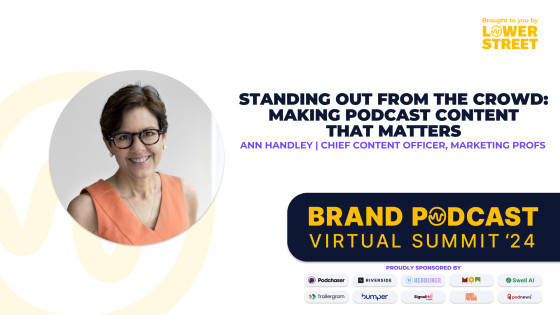Contents

When companies consider launching a podcast as part of their marketing strategy, one of the biggest questions is: How do we measure ROI? Creating a high-quality podcast requires a significant investment, so it’s only natural that higher-ups want to know if it will be worth it. At the Brand Podcast Summit, experts from Podscribe, Signal Hill Insights, and Morgan Stanley shared their insights on how brands can effectively measure the success of their podcasts.
Why Measuring ROI Matters
Every marketer wants to see their efforts pay off. Podcasting is no different, they need to prove the impact of a podcast. Unlike other digital marketing channels, podcasts are not as straightforward to track in terms of direct conversions. However, their value extends far beyond download numbers—they contribute to brand awareness, engagement, and long-term customer relationships.
Jamie Roô from Morgan Stanley highlighted this challenge: "We knew from our research that potential clients found financial advising intimidating. Our podcast, What Should I Do With My Money?, was designed to demystify financial advice and build trust. But proving its impact beyond anecdotal success stories was critical."
Key Methods for Measuring Podcast ROI
There’s a few different ways that you can measure the ROI of your podcast. Here are two popular methods.
Brand Lift Studies
Matt Hird from Signal Hill Insights explained that brand lift studies help measure a podcast's impact on brand perception. These studies use controlled exposure tests, where one group listens to the podcast while another does not. By comparing results, marketers can assess key factors such as:
Brand Familiarity: How many listeners recognize the brand post-exposure?
Purchase Intent: Does the podcast increase the likelihood of a listener engaging with the brand?
Brand Affinity: Does the podcast create a positive association with the brand?
Hird emphasized the halo effect of branded podcasts: "If a podcast provides valuable content, listeners perceive the brand in a positive light, strengthening long-term relationships."
Pixel Attribution
On the more technical side, Amelia Coomber from Podscribe discussed how pixel attribution allows brands to track listeners' online behavior after exposure to a podcast. This includes:
Website Visits: Did listeners visit the brand’s site after hearing the podcast?
Lead Generation: Did they sign up for a newsletter or consultation?
Conversions: Did they ultimately make a purchase?
Pixel attribution works by placing tracking pixels in both the podcast ads and the brand's website. When a listener who heard the podcast visits the website, the pixel identifies the match, helping brands connect podcast exposure to actual online actions.
Coomber noted that while pixel tracking is often associated with advertisers, branded podcasts can also leverage it to understand audience behavior and optimize content. "The ability to track engagement over time helps brands refine their podcast strategy and demonstrate ROI in real-time."
Beyond Metrics: Overcoming ROI Challenges
Measuring podcast ROI isn’t without its challenges. Unlike digital ads that can show immediate conversions, podcasts often serve as top-of-funnel awareness tools. Jamie Roô acknowledged this reality: "Someone isn’t likely to listen to one episode and immediately sign up for wealth management services. But over time, as they continue to engage, they’re more likely to trust us when the time comes to make that decision."
To tackle this, Morgan Stanley in particular uses a multi-layered approach:
Tracking Completion Rates: Understanding if listeners engage with the full episode, or at least a good part of it.
Leveraging Vanity URLs & Show Notes Links: Monitoring the traffic that comes directly from the podcast.
Using Listener Feedback & Anecdotal Evidence: Identifying audience impact beyond raw data.
Roô also highlighted an unexpected but powerful result: "We’ve had clients reach out to our financial advisors specifically because they heard them on the podcast. Even a single high-value client can justify the cost of producing a season."
The Future of Podcast ROI Measurement
As measurement tools evolve, brands are increasingly able to measure the long-term impact of their shows.
Here’s one thing brands need to know: Podcasts shouldn’t be judged by immediate conversions alone. Instead, they should be seen as a strategic tool for building relationships, trust, and brand authority—things that drive ROI over time.
By combining brand lift studies, pixel attribution, engagement metrics, and qualitative feedback, brands can develop a clear picture of their podcast’s value. And as more sophisticated tracking technologies emerge, measuring podcast ROI will only become more precise.
Final Thoughts
For marketers facing pressure to justify a podcast, it’s important to get on the same page with leadership about what success would look like. Setting clear goals from the beginning, defining measurable objectives, and continuously refining strategies based on data ensures that branded podcasts deliver lasting value.
As Roô concluded, "At the end of the day, it’s about creating high-quality content that resonates with your audience. When you do that well, the ROI follows."
You can watch the full replay of this session here.
Ready to start your own podcast?
If you need help creating your branded podcast, contact us today to get started.
Get In Touch




